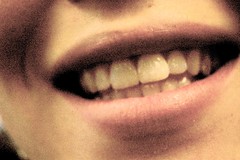 Photo by chdxx
Photo by chdxx
A few weeks ago, a patient asked me to treat her with acupuncture during her visit to the dentist. She needed to have a filling replaced, and the last time she had a treatment that required anesthesia, she experienced several adverse side effects from the medication.
We arrived at the dentist office early, and I inserted the needles to give her some time before the dental procedures began. I used an acupoint in her left jaw, and another in the hand (between thumb and forefinger), to help with pain management during the procedure. I also used ear tacks at the Jaw and Relaxation points.
Richard Knight, DMD, of Portland Family Dentistry was very welcoming, and his assistant Crystal was attentive to both the patient and myself during the procedure. When my electro-acupuncture machine had a temporary setback, they generously gave me extra batteries and waited patiently until the machine came back to life (insert momentary internal panic here.....) We were able to proceed in a minute or two with minimal sensation for the patient. We quickly found a rhythm of when the dentist and assistant began working on her tooth, I would turn up the levels of stimulation, then turn it back down as soon as they were finished. We worked using hand signals: thumbs up ("turn it up!"), thumbs down ("turn it down!"), or "ok" sign ("leave it there!").
The patient was able to have the entire two-hour procedure without any anesthetic. She is an incredibly brave woman, in my humble opinion, and I am looking forward to attending the next filling with her in a few weeks.
She gave great feedback, and asked to write a testimonial:
Recently I've had to have several fillings replaced. I've had to carefully schedule my appointments because I don't know how I'll feel afterward from the local anesthesia. Often I feel dull and slow as well as the usual numb face. Twice I've had full body reactions where I have severe stomach pain. After the last one I called Amy for help. Since I am also studying acupuncture I decided that I needed to put my money where my mouth is. I came out from the experience feeling very positive. I was very fearful going in because who really wants to feel the dentist drill? I was thankful that my dentist was open to having Amy come along. She was very calming and not only fell into rhythm with the dentist but also did shiatsu massage on my legs between work to help ground me. It was comforting to have an ally throughout the procedure. It wasn't completely sensation free but I never felt anything that caused great concern, my fear was the greatest obstacle. At the end I could help the assistant adjust my filling because I could feel my mouth and when I walked out I felt great. I even went to breakfast right afterward. Overall a thumbs up- we are going to do it again next time. Thanks Amy!
My advice to you if you are interested in using acupuncture with dental procedures would be to test it out with your practitioner before the appointment. Be sure to let the dentist know you are electing to use this instead of anesthesia, and that your dentist and assistant are willing to work with an acupuncturist. I also recommend meditation and breathing techniques, as that was also a large part of the patient staying relaxed during the long procedure.
Smile by lenifuzhead



